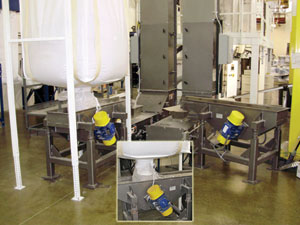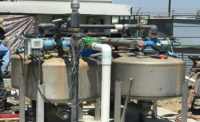Giant Snacks of Wahpeton, ND prides itself in selecting superior hybrids from contract growers in North Dakota to produce the best sunflower seeds in the US for its customer base. From its original recipe of roasted and salted sunflower seeds, Giant Snacks has expanded the line to offer a variety of flavors including BBQ, dill pickle, salt and pepper, ranch and, since early 2009, spicy garlic.

|
|
Twin vibratory feeders from Gough Econ are part of an integrated packaging line to feed existing Gough Econ bucket elevators, which deliver sunflower seeds to weighers and packaging equipment. Source: Gough Econ. |
Sunflower seeds are sold to consumers in packages ranging from 0.8 oz. to 14 oz. To process and package more than 2.5 million pounds of sunflower seeds each year, Giant Snacks operates two eight-hour shifts, five days a week.
“Quality assurance is important throughout the production process to make sure shells are not broken or dirty, are firm and do not have a limp texture. All packages are nitrogen flushed to assure shelf freshness,” says Al Engstrom, Giant Snacks plant manager.
Just as quality is important in selecting and packaging the seeds, totally automating its two integrated packaging lines was a priority for the processor to increase productivity.
To close the production loop, the processor added twin vibratory feeders from Gough Econ to feed product automatically into existing Gough Econ “S” Series Swinglink bucket elevators. The Swinglink system consists of 180 nine-in. wide polypropylene buckets impregnated with a glass fiber resin to prevent staining and enable ease of product flavor change. Engstrom says that automating the operation has helped considerably in meeting productivity and quality goals.
Super sacks containing roasted sunflower seeds are hung over the twin vibratory feeders. An opening on the bottom of the super sacks feeds the seed to the six-ft. long-by-one-ft. wide vibratory feeders that operate at a rate of 3,000 lbs./hour.
Four coil springs on the frame assembly of the feeders minimize vibration transfer and assure gentle handling of the material with minimum breakage as it travels to the bucket elevators. The buckets remain in a horizontal position throughout the circuit except at the discharge point to the form, fill and seal packaging equipment. Keeping the buckets in a horizontal position assures product integrity and keeps the buckets overlapped to prevent product spillage.
“This design ensures free falling of product from the buckets without product spillage,” says Engstrom. “The smooth bucket surface eliminates product trap areas and provides an excellent means of transfer into a single plane.
“The Gough Econ units are a major part of our automation process and have been operating flawlessly,” notes Engstrom.
He notes the feeders have added reliability and flexibility into the production line and assure gentle handling of the product. Plus, he says the feeders operate economically and efficiently using minimum power. Vibratory feeders or screens are typically used when applications are beyond the scope of an electromagnetic drive and in particular when units require lengths in excess of five feet and widths greater than 18 inches.
From the bucket elevators, product is pneumatically discharged over the end of each bucket into a hopper and gravity fed into Yamato Data Weight Sigma Plus series scales, part of the Hayssen/Sandiacre Ultima ST Panel View 600 Model 12-19 fill-and-seal machine. After sealing, the package runs through a case taper where bar codes are added along with the size, Julian date code, time packed and who packed it. v
For more information:
Andy Leitch, 704-399-4501, aleitch@goughecon.com




